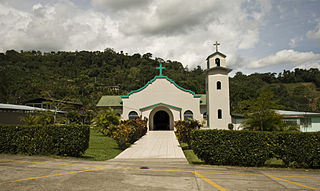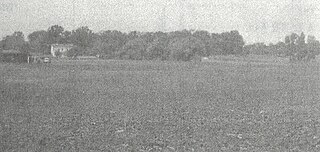Related Research Articles

Pila, officially the Municipality of Pila, is a 3rd class municipality in the province of Laguna, Philippines. According to the 2020 census, it has a population of 54,613 people.

Korean ceramic history begins with the oldest earthenware from around 8000 BC. Throughout the history, the Korean peninsula has been home to lively, innovative, and sophisticated art making. Long periods of stability have allowed for the establishment of spiritual traditions, and artisan technologies specific to the region. Korean ceramics in Neolithic period have a unique geometric patterns of sunshine, or it is decorated with twists. In Southern part of Korea, Mumun pottery were popular. Mumun togi used specific minerals to make colors of red and black. Korean pottery developed a distinct style of its own, with its own shapes, such as the moon jar or Buncheong sagi which is a new form between earthenware and porcelain, white clay inlay celadon of Goryeo, and later styles like minimalism that represents Korean Joseon philosophers' idea. Many talented Korean potters were captured and brought to Japan during the invasions of Korea, where they heavily contributed to advancing Japanese pottery. Arita ware, founded by Yi Sam-pyeong opened a new era of porcelain in Japan. Another Japanese representative porcelain, Satsuma ware was also founded by Dang-gil Shim and Pyeong-ui Park. 14th generation of Su-kwan Shim have been using the same name to his grandfather and father to honor they are originally Korean, 14th Su-kwan Shim is honorable citizen of Namwon, Korea.

The Grand Village of the Illinois, also called Old Kaskaskia Village, is a site significant for being the best documented historic Native American village in the Illinois River valley. It was a large agricultural and trading village of Native Americans of the Illinois confederacy, located on the north bank of the Illinois River near the present town of Utica, Illinois. French explorers Louis Joliet and Father Jacques Marquette came across it in 1673. The Kaskaskia, a tribe of the Illiniwek people lived in the village. It grew rapidly after a French mission and fur trading post were established there in 1675, to a population of about 6,000 people in about 460 houses. Around 1691 the Kaskaskia and other Illiniwek moved further south, abandoning the site due to pressure from an Iroquois invasion from the northeast.

The Campbell Archeological Site (23PM5), is an archaeological site in Southeastern Missouri occupied by the Late Mississippian Period Nodena phase from 1350 to 1541 CE. The site features a large platform mound and village area, as well as several cemeteries. The site was excavated by amateur archaeologist Leo O. Anderson and Professor Carl Chapman from 1954 to 1968 and subsequently published the first material on the site in 1955. The site has yielded the largest number of Spanish artifacts of any prehistoric site in Southeastern Missouri. Finds at the site included glass chevron beads, a Clarksdale bell, iron knife fragments and part of a brass book binder. It was added to the NRHP on July 24, 1974 as NRIS number 74001086.

Unguja Ukuu is a historic Swahili settlement on Unguja island, in Zanzibar, Tanzania.

The Younge site is an archeological site located in Goodland Township, Lapeer County, Michigan. It is classified as a prehistoric Late Woodland site and was designated as a Michigan State Historic Site on October 29, 1971. It was added to the National Register of Historic Places on October 29, 1976.

The Juntunen site, also known as 20MK1, is a stratified prehistoric Late Woodland fishing village located on the western tip of Bois Blanc Island. It was listed on the National Register of Historic Places in 1978.

Sinauli is an archaeological site in western Uttar Pradesh, India, at the Ganga-Yamuna Doab. The site gained attention for its Bronze Age solid-disk wheel carts, found in 2018, which were interpreted by some as horse-pulled "chariots".
Part of series of articles upon Archaeology of Kosovo
Dewil Valley, located in the northernmost part of Palawan, an island province of the Philippines that is located in the Mimaropa region, is an archaeological site composed of thousands of artifacts and features. According to the University of the Philippines Archaeological Studies Program, or UP-ASP, the closest settlement can be found in New Ibajay, which is covered by the town capital of El Nido, which is located around 9 km (5.6 mi) south-east of Dewil Valley. Physically it measures around 7 km (4.3 mi) long, and 4 km (2.5 mi) wide. It is in this place which the Ille Cave, one of the main archaeological sites, can be found. It is actually a network of 3 cave mouths located at its base. It has been discovered that this site in particular has been used and occupied by humans over multiple time periods.
Porac, Pampanga contains areas in and near Babo Balukbuk in Porac, Philippines that have strong indication of human habitation, according to investigations published on the University of the Philippines Archaeological Studies Program website. Later test excavations confirmed this conclusion through the presence of materials dated around the 12th century to the 17th century C.E.
Pinagbayanan is a barrio in the municipality of Pila, Laguna, Philippines. The 2010 census estimates its population at 5,305 people. Archaeological excavations in the area have contributed to developments in the field of ceramics and led to the recognition of the importance of the area to archaeology.

Rivas is a district of the Pérez Zeledón canton, in the San José province of Costa Rica.
The Huber Site (11Ck-1) is located on Tinley Creek 2 miles west of Blue Island in Cook County, Illinois, near the city of Chicago. It is classified as a late prehistoric site with Upper Mississippian affiliation.

The Knoll Spring site (11Ck-19), aka Au Sagaunashke village, is located in the Sag Valley, Palos Hills, in Cook County, Illinois, near the city of Chicago. It is classified as a late prehistoric site with Upper Mississippian Huber affiliation.
The Anker Site (11Ck-21) is located on the Little Calumet River near Chicago, Illinois. It is classified as a late prehistoric site with Upper Mississippian Huber affiliation.
The Fisher Mound Group is a group of burial mounds with an associated village site located on the DesPlaines River near its convergence with the Kankakee River where they combine to form the Illinois River, in Will County, Illinois, about 60 miles southwest of Chicago. It is a multi-component stratified site representing several Prehistoric Upper Mississippian occupations as well as minor Late Woodland and Early Historic components.
The Carcajou Point site is located in Jefferson County, Wisconsin, on Lake Koshkonong. It is a multi-component site with prehistoric Upper Mississippian Oneota and Historic components.
The Fort Wayne mound site was a prehistoric burial mound located on the grounds of the Ordinance Department of the former Fort Wayne in Detroit, Michigan. It was one of a series of mounds in Detroit, including the Springwells Mound Group, the Carsten mound and the Great mound at the River Rouge. By the mid-20th century only the Fort Wayne mound was still standing. Today, the remains of the mound—located near Officers' Row—is fenced off to visitors.
The Brateiu archaeological complex is an archaeological site consisting of several tombs and a settlement, in Transylvania, Romanian. The site contains archaeological finds from several periods. There are 2 archaeological layers, officially known as Brateiu 1, Brateiu 2 which can be distinguished by age. The oldest archaeological site, Brateiu 1, dates back to the 4th century, while Brateiu 2 dates to the 8th century.
References
- ↑ Beyer, H. Otley. 1947. Outline Review of Philippine Archaeology by Islands and Provinces. The Philippine Journal of Science, Vol 77, July–August.
- 1 2 Tenazas, Rosa C.P., A Report on the Archaeology of the Locsin - University of San Carlos Excavations in Pila, Laguna
- 1 2 "Treasures of Pila: Pila in Ancient Times". Archived from the original on 2015-04-23. Retrieved 2015-05-17.
- 1 2 Vitales, Timothy James. 2013. Archaeological Research in the Laguna de Bay area, Philippines. Hukay, Volume 18.
- 1 2 "Official Website of Pila, Laguna". Archived from the original on 2015-05-18. Retrieved 2015-05-17.